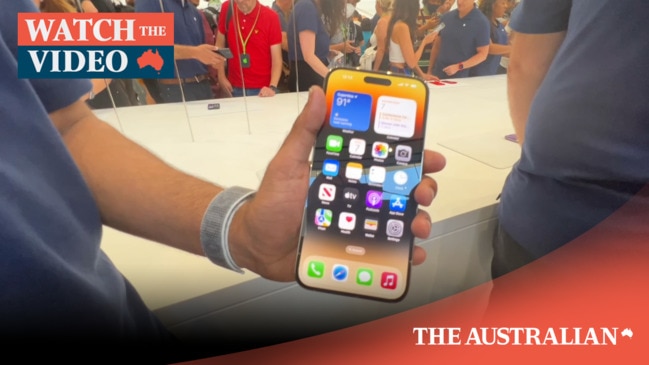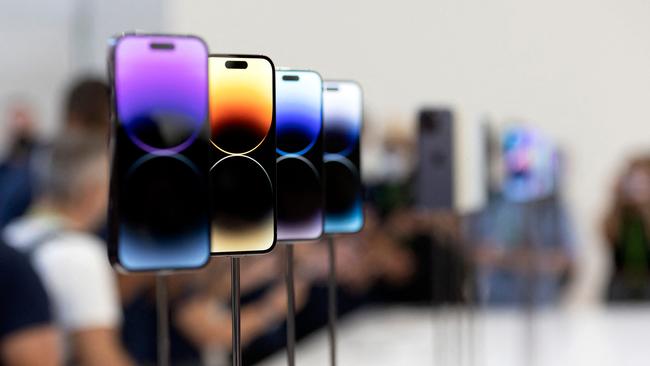iPhone 14, iPhone 14 Pro, iPhone 14 Pro Max review: Is it worth the upgrade as consumers battle inflation?
Comparing Apples to Apples, latest smartphone offers multiple battery life and camera improvements, but are they enough?

Apple’s iPhone 14 line-up is offering customers a bargain option. While prices have risen, you can buy cheaper versions of the 6.1-inch and 6.7-inch handsets, which are as fast as Apple’s fastest phone in 2021.
Benchmark testing using AnTuTu version 9.1.1 bears this out. Last year’s top-of-range iPhone 13 Pro Max scored 840,023. That’s fast. But this year’s plain-old iPhone 14 does almost as well, scoring 825,740. This is because the basic 2022 iPhones are configured with the fastest A15 processors of 2021.
Last year you’d pay $1699 or $1899 for that speed; this year it’s $1399 or $1579 with standard models depending on size.

But you forgo Apple’s premium camera and make do with a two-lens system. There’s no telephoto, so you are restricted to 1x optical and 5x hybrid zoom instead of 3x optical and 15x hybrid zoom. You also miss a swag of pro camera features, but if fast operation is your priority, such as with mobile gaming, it’s an option. I believe standard models will be popular.
Comparing Apples to Apples, pricing has increased, with this year’s basic iPhone 14 costing $170 more.
I have tested three of four new iPhones: the 14, 14 Pro and 14 Pro Max. They sell from September 16. The 14 Plus sells from October 7.
2022 pro models have even faster A16 chips scoring in the 960,000 range with AnTuTu.
The 14 and 14 Pro are almost the same dimensions but the 14 Pro is significantly heavier – 206g versus 172g.
The standard and pro models both have Super Retina XDR OLED displays, but the pro screens can be much brighter, up to 2000 nits as opposed to 1200 nits for standard models.

The ability of pro models to slow the screen refresh to one Hertz and save power enables Apple to include an always-on display when the phone is locked, without draining the battery.
I checked to see if always-on caused battery drain and found it was about 1 per cent per hour, no more than with the non-pro model showing a blank display when locked.
The always-on display is configurable. I could choose widgets such as my next meeting, weather, activity metrics, and battery level.
Always-on displays are not new. They debuted on Nokia AMOLED Symbian phones more than a decade ago.
I checked the overall battery consumption of these models, playing 1080p continuously, at 300 nits brightness. The 14 lasted 18 hours 16 minutes, the 14 Pro Max 18 hours 34 minutes, while the 14 Pro returned an uncharacteristically short 10 hours 2 minutes and was warm to touch.
I therefore discounted this last result.
During set up, the phones ask if I wish to transfer your mobile service to an eSIM. You are warned that your plastic SIM will be disabled. Australian models will support both plastic SIMs and eSIMs, but eSIM-only iPhones are probably only a year away in Australia, given Apple is introducing them this year in the US.
Don’t expect that your iPhone 13 Pro cover will fit an iPhone 14 Pro due to the larger lens sizes. Mine didn’t.
The major difference between standard and pro models is of course cameras. The 14/14 Plus has just 12MP wide and ultrawide lenses, plus a 12MP selfie lens now with autofocus that can focus differentially across a group shot.

The lack of a telephoto lens limits distance photography, such as snaps of the skyline of Sydney that I can take from 4km away.
Apple promises brighter and better colours and better low light photography with all models. I took the iPhone 14 handsets to a local Alice in Wonderland display and all models captured its splendour.
I could see slightly more detail and better colour handling in the pro camera shots, but I had to look closely.
All models performed well in low lighting conditions, although the pro models preserved slightly more colour. I still prefer Google and premium Samsung phones for night photo captures of landscapes in low light.
Apple’s best zoom capability is conservative by Android standards, with this year’s Samsung S22 taking great photos at 30x hybrid zoom.
Apple did announce a slew of features for the pro models, such as a “photonic engine”, an evolution of deep fusion where the iPhone takes different shots at different settings to provide more even lighting.
The pro models feature a 48MP wide angle lens and a larger sensor with a 24mm focal length for landscapes and group photos.

But it’s getting harder for Apple to show further improvements in image quality as it has already improved photo quality with AI photography. It’s about that final 1 per cent improvement.
The exception is zoom where Apple needs to catch up. A periscope lens is rumoured for next year.
The black notch that houses the front camera elements finally has been replaced by a smaller capsule-size cutout that marginally increases screen space on pro models.
Apple’s is trialling its “dynamic island” notifications on pro models, which morph shape to attract your attention and present information. Notifications can include actions such as start/pause buttons to play music.
Standard models have an aluminium frame and come in black, white, blue, purple and red, while pro models are made from stainless steel with black, silver, gold and purple options.

For many users, the best news is Apple’s iOS16 operating system being available to existing phones, which I have been using. The integration of the keyboard with voice dictation when texting is a winner, as it’s much easier to correct misspellings.
Having multiple home screens linked to focus modes means I can shift from taking just personal calls to work calls in a swipe. The introduction of iCloud shared photo libraries makes it easier for friends and families to share and edit photos together.
Chris Griffith attended Apple’s product launch in California courtesy of Apple.






To join the conversation, please log in. Don't have an account? Register
Join the conversation, you are commenting as Logout